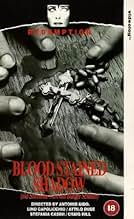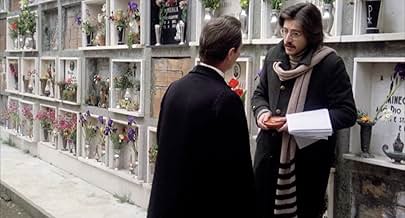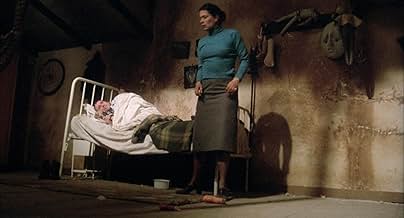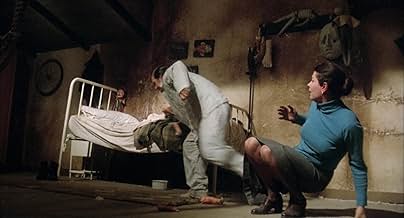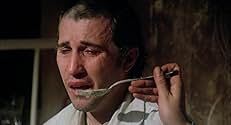NOTE IMDb
6,3/10
2,2 k
MA NOTE
Le corps d'une écolière est retrouvé dans une prairie. Le meurtrier n'est jamais arrêté et, des années plus tard, un jeune homme nommé Stefano retourne sur l'île et retrouve son frère, le pr... Tout lireLe corps d'une écolière est retrouvé dans une prairie. Le meurtrier n'est jamais arrêté et, des années plus tard, un jeune homme nommé Stefano retourne sur l'île et retrouve son frère, le prêtre local.Le corps d'une écolière est retrouvé dans une prairie. Le meurtrier n'est jamais arrêté et, des années plus tard, un jeune homme nommé Stefano retourne sur l'île et retrouve son frère, le prêtre local.
- Réalisation
- Scénario
- Casting principal
Craig Hill
- Don Paolo
- (as Graig Hill)
Alina De Simone
- Medium
- (as Alina Simoni)
Sonia Viviani
- Girl walking with Signora Nardi
- (as Sonia Vivani)
Fortunato Arena
- Antonio, Innkeeper
- (non crédité)
Antonio Bido
- Man at cemetary
- (non crédité)
Eolo Capritti
- Customer in restaurant
- (non crédité)
Avis à la une
Not unlike the previous years offering from the same director, Watch Me When I Kill, this giallo is somewhat different from the usual genre fare and despite being as complicated as his other and once more with a red herring on every corner and not the bloodiest of kills, this is most enjoyable. The added benefit here is the Venice setting and not the chocolate box, pretty, pretty Venice but the more realistic representation with dark narrow alleyways, cold mist rising from the dark waters and gloomy buildings in various states of decay. There are even more scenes set in the evocative, off the beaten track, Murano. But no delicate glass blowing to be seen, more the back gardens, back alleys and backwaters, all adding to the gloom of this evocative and fascinating picture.
Directed by Antonio Bido, this is by far his best film of his career (Though, admittedly, his only other film of any note is the 1977 Giallo "Watch Me When I Kill").
The film's narrative is relatively typical of a giallo: Someone is killing people in a small village and a priest tries to unravel the mystery of the killer's identity. What's atypical is the film's tone. The film is noteworthy for being one of the more serious and mature of the giallo genre. Bido avoids the giallo's often sleazy nature and embraces the Gothic and religious aspects instead.
Another interesting point is how the film focuses on two main protagonists, the priest and his brother, and how they collaborate with one another to discover the killer. Interesting narrative method having two focal points rather than one, not original but unconventional.
The performances are generally good with Craig Hill as giving an impressive performance as the priest. He exhibits a broad range of emotions from anger to sorrow, from determination to helplessness, and makes it totally convincing.
The cinematography is main feature of the film because it is its strongest trait. The visuals portray a wet and muggy Italy, with fog and mist enveloping the landscapes and rain falling, creating pools of water. This all builds a gloomy and foreboding atmosphere that conveys feelings of isolation, loneliness, dread, anguish, and death.
The characters are generally good as well, each with a strong history and believable relationships between one another. The greatest of which is the relationship between the priest and his brother, which is totally believable because not only of both of their performances, but also the development of their characters.
And lastly, the film features some wonderful aesthetic qualities through it's use of editing. Bido inter splices Catholic and Religious imagery to make comments about the characters and the religious institution as a whole.
The film has a few problematic issues. First of all, the narrative isn't clearly focused. The film appears to be more concerned with the visuals and the individual, isolated events in the film rather than the mystery as a whole. Thus, this damages the film's impact as it approaches the end, because here the mystery plays center stage but is underdeveloped.
The narrative also suffers from several of the genre's conventions and clichés, thus leading to a sort of predictability of the story. The film features the typical gloved killer, the extended stalking sequences leading to a gruesome death, the multiple red herrings, childhood traumas, and a host of other archetypes of the giallo.
Also, the final revelation stretches plausibility and thus may become unacceptable to some viewers, especially when one recalls the events that have transpired throughout the film.
Never the less, this is one of the better giallos out there.
Recommended to those who enjoy the mystery/thriller genre, though it is not essential unless you are a fan of the giallo genre. For the casual film viewer, there are better examples of the giallo genre and thus would recommend that you skip this and view one of the apexes of the genre such as Suspiria.
The film's narrative is relatively typical of a giallo: Someone is killing people in a small village and a priest tries to unravel the mystery of the killer's identity. What's atypical is the film's tone. The film is noteworthy for being one of the more serious and mature of the giallo genre. Bido avoids the giallo's often sleazy nature and embraces the Gothic and religious aspects instead.
Another interesting point is how the film focuses on two main protagonists, the priest and his brother, and how they collaborate with one another to discover the killer. Interesting narrative method having two focal points rather than one, not original but unconventional.
The performances are generally good with Craig Hill as giving an impressive performance as the priest. He exhibits a broad range of emotions from anger to sorrow, from determination to helplessness, and makes it totally convincing.
The cinematography is main feature of the film because it is its strongest trait. The visuals portray a wet and muggy Italy, with fog and mist enveloping the landscapes and rain falling, creating pools of water. This all builds a gloomy and foreboding atmosphere that conveys feelings of isolation, loneliness, dread, anguish, and death.
The characters are generally good as well, each with a strong history and believable relationships between one another. The greatest of which is the relationship between the priest and his brother, which is totally believable because not only of both of their performances, but also the development of their characters.
And lastly, the film features some wonderful aesthetic qualities through it's use of editing. Bido inter splices Catholic and Religious imagery to make comments about the characters and the religious institution as a whole.
The film has a few problematic issues. First of all, the narrative isn't clearly focused. The film appears to be more concerned with the visuals and the individual, isolated events in the film rather than the mystery as a whole. Thus, this damages the film's impact as it approaches the end, because here the mystery plays center stage but is underdeveloped.
The narrative also suffers from several of the genre's conventions and clichés, thus leading to a sort of predictability of the story. The film features the typical gloved killer, the extended stalking sequences leading to a gruesome death, the multiple red herrings, childhood traumas, and a host of other archetypes of the giallo.
Also, the final revelation stretches plausibility and thus may become unacceptable to some viewers, especially when one recalls the events that have transpired throughout the film.
Never the less, this is one of the better giallos out there.
Recommended to those who enjoy the mystery/thriller genre, though it is not essential unless you are a fan of the giallo genre. For the casual film viewer, there are better examples of the giallo genre and thus would recommend that you skip this and view one of the apexes of the genre such as Suspiria.
Sounds a bit strange that Antonio Bido just had few movies as director until now, this second entry on Giallo where he co-wrote and directed, however was his final movie in this specific genre, here he brings a holy figure of the Church, a Priest Don Paolo (Craig Hill) when arrives nearby Venice his young brother Stefano (Lino Capolicchio) a professor stressed by strange visions of the past over an unsolved murder of a girl, Lino has an occasional meeting at train's cabin with Sandra (The eye candy Stefania Casini), Lino was received warmly by Don Paolo, implying a true fraternal feelings, the Priest introduces to Lino his worries over weird facts in the little community, about a small group consisting by a Medium, a Doctor, a Middle age woman and a decaying drunkard Count, soon starts other crimes, even linked on those small group pointed out by Don Paolo, wisely the Director puts countless clues trying deceives the viewer, also Bido exposes on slight portions two sensitive matter which the Church faces nowadays, one woman complains to the Priest that his boy has been abused by the Count Pedrazzi (Massimo Serato) on his confession, indeed the rotten Count probable did such backbiting, due it was widely clear on his odd behavior with your butler, further he presents the Priest as all we know recognize as an unambiguous character, good movie!!
Resume:
First watch: 2020 / How many: 1 / Source: DVD / Rating: 7
Resume:
First watch: 2020 / How many: 1 / Source: DVD / Rating: 7
Nothing more than an honest italian giallo, this movie tells the torbid story of a string of murders in a small town in the Venice laguna. A young mathematician will find the answer to one of his early nightmares, but he will not like the taste of it. A good music and a good atmosphere don't totally hide a lacking script (a few of the acts of the murderer are without a real, logical explanation), but this is the norm in several of more routinely italian gialli.
In this heavily plotted Giallo from director / co-writer Antonio Bido, two brothers have a reunion that unfortunately goes sour when graphic murders begin to take place. Stefano D'Archangelo (Lino Capolicchio), the professor, works the clues while taking the time to romance Sandra (Stefania Casini), a new acquaintance, while his priest brother Don Paolo (Craig Hill) is worried that he will be among the victims when he witnesses an assault and soon starts receiving threatening notes.
Not all fans of Italy's Giallo genre may be too enamored with this one as it simply isn't as trashy as some of them. The murders do get fairly intense (one victim has their head shoved into a roaring fire), but the amount of bloodshed is minimal (title of the film notwithstanding). There is also a sex scene and nudity from Casini, but these are done in a tasteful manner, perhaps too tasteful for some viewers.
While Bidos' direction is good, he never lets style take over, preferring to concentrate first and foremost on telling the story. He lets his film unfold at a very deliberate pace; he devotes a fair amount of time to Stefanos' courting of the lovely Sandra, who works as a painter. As a result, one might grow impatient waiting for the next major set piece.
Still, when these set pieces come, they prove to be worth the wait, such as a sequence of Sandra being stalked as she heads home. The story twists are entertaining, and keep the audience guessing; there are of course red herrings, and the identity of the disturbed killer might come as a shock to some of you.
One of the strongest assets here is the way Bido utilizes the Venice setting; the sights and sounds are a pleasure to take in. The music score by Stelvio Cipriani runs hot and cold - sometimes it's quite atmospheric, at other times it's just too offbeat to really work, especially when it's used for suspense sequences.
The cast is solid, with Capolicchio and Hill making for a likeable sibling duo; Capolicchio is also a refreshingly different sort of hero as he has a real average Joe quality.
This isn't among the absolute best of its kind but it's still pretty good; aficionados should be reasonably satisfied. The ending is awfully abrupt, though.
Seven out of 10.
Not all fans of Italy's Giallo genre may be too enamored with this one as it simply isn't as trashy as some of them. The murders do get fairly intense (one victim has their head shoved into a roaring fire), but the amount of bloodshed is minimal (title of the film notwithstanding). There is also a sex scene and nudity from Casini, but these are done in a tasteful manner, perhaps too tasteful for some viewers.
While Bidos' direction is good, he never lets style take over, preferring to concentrate first and foremost on telling the story. He lets his film unfold at a very deliberate pace; he devotes a fair amount of time to Stefanos' courting of the lovely Sandra, who works as a painter. As a result, one might grow impatient waiting for the next major set piece.
Still, when these set pieces come, they prove to be worth the wait, such as a sequence of Sandra being stalked as she heads home. The story twists are entertaining, and keep the audience guessing; there are of course red herrings, and the identity of the disturbed killer might come as a shock to some of you.
One of the strongest assets here is the way Bido utilizes the Venice setting; the sights and sounds are a pleasure to take in. The music score by Stelvio Cipriani runs hot and cold - sometimes it's quite atmospheric, at other times it's just too offbeat to really work, especially when it's used for suspense sequences.
The cast is solid, with Capolicchio and Hill making for a likeable sibling duo; Capolicchio is also a refreshingly different sort of hero as he has a real average Joe quality.
This isn't among the absolute best of its kind but it's still pretty good; aficionados should be reasonably satisfied. The ending is awfully abrupt, though.
Seven out of 10.
Le saviez-vous
- AnecdotesAt 28'51' when Capolicchio introduces himself to Stefania Casini he tells her he is a Professor of Mathematics, Casini tells him that her job is to deal with furniture and Capolicchio calls her Architect, Stefania Casini actually graduated in Architecture at Polythechnic University of Milan.
- GaffesWhen the killer is being revealed and the main character pulls out the newspaper article, you can see and hear a flash from camera, probably taking pictures of the scene.
- ConnexionsFeatured in Solamente Bido (2002)
Meilleurs choix
Connectez-vous pour évaluer et suivre la liste de favoris afin de recevoir des recommandations personnalisées
- How long is The Bloodstained Shadow?Alimenté par Alexa
Détails
- Durée
- 1h 49min(109 min)
- Mixage
- Rapport de forme
- 1.85 : 1
Contribuer à cette page
Suggérer une modification ou ajouter du contenu manquant

